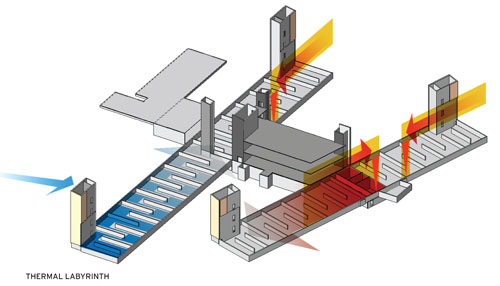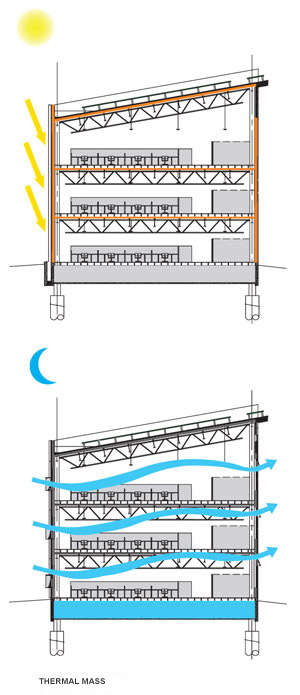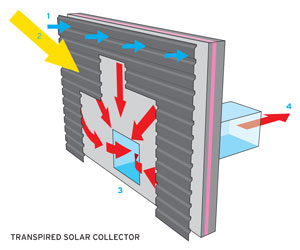Zeroing In on Net-Zero Energy
In addition to reducing the energy consumed by lighting fixtures, this tactic produced a number of additional benefits, including a corresponding reduction in the heat rejected from the lighting, which in turn lessened cooling loads and the portion of the budget that would need to be allocated to mechanical systems and the PV array.
One consequence of the building's configuration, with its elongated, daylight-oriented wings, was more exterior envelope than would have been required by a scheme enclosing the same volume but with deeper floor plates. As a result, the skin was an important focus of the project team's efforts. Designers developed an assembly of insulated precast concrete panels with the required thermal properties. These components had the added benefit of helping speed construction because of their off-site fabrication. Windows, which are triple-glazed, make up only about 25 percent of the long north and south facades. On the much smaller east and west elevations, electrochromic and thermochromic glass, or so-called switchable glazing, helps control heat gain and glare.
 |
Below the RSF's footprint is a crawl space containing staggered poured-in-place concrete walls. This "thermal labyrinth" stores heat from air warmed by the transpired solar collectors and heat rejected from the data center. The stored thermal energy is used to preheat ventilation air during the winter. Cool air can be drawn into the crawl space through corner towers to purge heat from the concrete mass. Diagram: Courtesy RNL |
The building envelope also incorporates NREL-developed technology - devices called "transpired solar collectors" that consist of perforated corrugated metal mounted on the south facades. These rely on the sun to passively preheat outside air trapped in the cavity between the collectors and the precast panels making up the weatherproof enclosure. The air is then drawn into a crawl space underneath the building. In the winter, the heat from this outside air, along with waste heat from the data center, is stored in the staggered poured-in-place concrete walls making up this "thermal labyrinth." This stored thermal energy is subsequently used to preheat ventilation air delivered to the offices through a raised floor system. In the summer, cool night air flushes the labyrinth and the RSF's occupied spaces. The inertia of the exterior walls, which are left exposed without a drywall interior finish, along with the radiant piping embedded in the ceiling slabs, helps maintain the occupants' thermal comfort throughout the course of the day.
 |
 |
ABOVE:
LEFT: The building's precast concrete cladding is exposed on the interior, providing thermal mass. The walls store excess heat over the course of a summer day, reducing the cooling load. When nighttime interior temperatures exceed 70 degrees, operable windows automatically open, allowing the thermal mass to cool.
Diagrams: Courtesy RNL |









